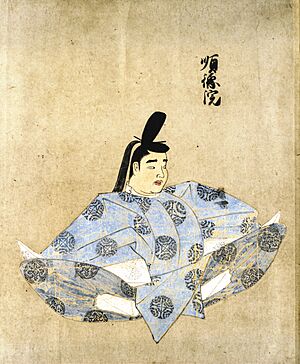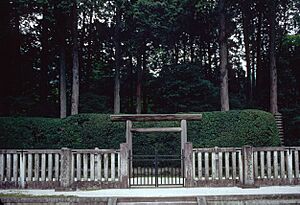Emperor Juntoku facts for kids
Quick facts for kids Emperor Juntoku順徳天皇 |
|||||
|---|---|---|---|---|---|

Juntoku, Tenshi Sekkan Miei (15th century)
|
|||||
| Emperor of Japan | |||||
| Reign | December 12, 1210 – May 13, 1221 | ||||
| Coronation | January 14, 1211 | ||||
| Predecessor | Tsuchimikado | ||||
| Successor | Chūkyō | ||||
| Shōgun | Minamoto no Sanetomo | ||||
| Born | October 22, 1197 | ||||
| Died | October 7, 1242 (aged 44) Sado Island, Kamakura shogunate |
||||
| Burial | Ōhara no Misasagi (大原陵) (Kyoto) | ||||
| Spouse |
Fujiwara no Ritsushi
(m. 1211) |
||||
| Issue more... |
Emperor Chūkyō | ||||
|
|||||
| House | Yamato | ||||
| Father | Emperor Go-Toba | ||||
| Mother | Fujiwara no Shigeko | ||||
Emperor Juntoku (順徳天皇, Juntoku-tennō) (born October 22, 1197 – died October 7, 1242) was the 84th emperor of Japan. He ruled from 1210 to 1221.
Contents
Family and Early Life
Before becoming emperor, his personal name was Morinari-shinnō. He was the third son of Emperor Go-Toba. His mother was Shigeko, who was the daughter of Fujiwara Hanki.
Emperor Juntoku had several children. His most famous son was Imperial Prince Kanenari. This son later became Emperor Chūkyō.
Becoming Emperor
Morinari-shinnō became the Crown Prince in the year 1200. He became emperor after his father, Emperor Go-Toba, asked his older brother, Emperor Tsuchimikado, to step down.
- 1210: Emperor Tsuchimikado gave up his throne. His younger brother, Morinari-shinnō, became the new emperor. This is called senso. Soon after, Emperor Juntoku officially took the throne in a ceremony called sokui.
During Juntoku's time as emperor, his father, Emperor Go-Toba, still held most of the real power. This was a special system called Cloistered rule. It meant the retired emperor made the important decisions.
The Jōkyū War and Exile
In 1221, Emperor Juntoku was forced to step down from his role. This happened because he was part of a big event called the Jōkyū War.
This war was an attempt by Emperor Go-Toba to take back power from the Kamakura shogunate. The shogunate was a military government that ruled Japan at the time. Emperor Go-Toba wanted the Imperial family to have more control.
The attempt failed, and the shogunate won. Because of his involvement, Emperor Juntoku was sent away to Sado Island. He lived there until he died in 1242. People sometimes called him Sado-no In because he spent his last years on Sado Island.
A Poet Emperor
Emperor Juntoku was very interested in poetry. He learned from a famous poet named Fujiwara no Sadaie, also known as Teika.
One of Emperor Juntoku's poems was chosen for a very famous collection called the Ogura Hyakunin Isshu. This collection has 100 poems by 100 different poets. It is still well-known today. The poems from this collection are even used in a popular Japanese card game called uta karuta.
Eras of Juntoku's Reign
During Emperor Juntoku's time as ruler, different time periods were given special names. These are called nengō.
See also
- Emperor of Japan
- List of Emperors of Japan
- Imperial cult


